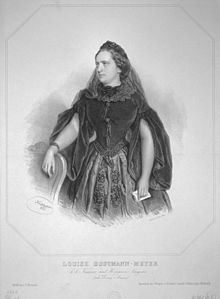Louise Dustmann-Meyer

Marie Luise Dustmann-Meyer , b. Meyer, also Louise Dustmann (born August 22, 1831 in Aachen , † March 2, 1899 in Charlottenburg near Berlin ) was a German opera singer ( soprano ) and singing teacher .
Life
Dustmann-Meyer was the daughter of the theater inspector Friedrich August Meyer and the opera singer Anna Maria Absenger, who met at the theater in Aachen and married in 1831. The future actress Marie Meyer (1840-1908) was her younger sister.
Dustmann-Meyer received her first musical training from her mother in Breslau , where she worked as a soubrette . At the age of 17 she went to Vienna for further lessons . According to an article in the Illustrirten Zeitung , she had "... to struggle with many difficulties during the October days of 1848 ..."
Dustmann-Meyer made his debut at the Theater in der Josefstadt in the 1848/49 season under the conductor Albert Lortzing . From there she got an engagement at the Wroclaw City Stage . From 1850 to 1851 she was engaged as a dramatic singer at the court theater in Kassel , where she achieved great success under Louis Spohr . In 1852 Dustmann-Meyer moved to the Dresden Court Opera , where she was under contract until 1854. Following this engagement, she was committed to the German Theater in Prague .
There, at the end of 1856, Archduke Franz Karl became aware of Dustmann-Meyer and asked for her position at the Vienna Court Opera . With effect from January 1, 1857, she was accepted into the ensemble. In 1858 she married the bookseller Adalbert Dustmann in Vienna. In 1860 she was appointed chamber singer . By 1875 she had seen and heard the grateful audience in almost every important role. That year Dustmann-Meyer ended her stage career with the role of Elsa von Brabant from Lohengrin by Richard Wagner . In the years 1877 and 1881 she appeared again as a guest in the court opera.
She was known not only as a dramatic singer, but also as a very renowned song singer. On January 5, 1870, she sang - together with Rosa Girzick , Gustav Walter and Emil Krauss - the first public performance of Brahms' collection of Liebeslieder-Waltzes , accompanied on the piano by the composer and Clara Schumann .
After leaving the stage in 1875, she was entrusted with a teaching position at the Conservatory of the Gesellschaft der Musikfreunde in Vienna . She held this office for almost five years until she and her husband settled in Berlin (Charlottenburg) in 1880.
In addition to the operas by Christoph Willibald Gluck , Wolfgang Amadeus Mozart and Carl Maria von Weber , she repeatedly sang in those by Richard Wagner. Dustmann-Meyer was best known as an interpreter of his operas. She had a long and detailed correspondence with Wagner, who always referred to her as "his singer". He also stood by her when, after 57 rehearsals in 1863, Tristan und Isolde was declared unperformable.
Louise Dustmann-Meyer died on March 2, 1899 in Berlin-Charlottenburg at the age of 67.
In 1936, Dustmannweg was named after her in Vienna- Ottakring (16th district) .
Schoolgirls (selection)
literature
- Constantin von Wurzbach : Meyer-Dustmann, Luise . In: Biographisches Lexikon des Kaiserthums Oesterreich . 18th part. Imperial-Royal Court and State Printing Office, Vienna 1868, p. 160 f. ( Digitized version ).
- Luise Dustmann , in: A. Ehrlich (Hrsg.): Famous singers of the past and present. A collection of 91 biographies and 90 portraits . Leipzig 1895, p. 38 f. ( Digitized version ).
- Dustmann-Meyer, Marie Louise , in: Deutsche Biographische Enzyklopädie , Vol. 2 . Saur, Munich 1995, p. 657.
- Michael Jahn : The Vienna Court Opera from 1848 to 1870. Personnel - performances - program. (= Publications of the Institute for Austrian Music Documentation 27). Tutzing 2002. ISBN 3-7952-1075-5 .
- Karl-Josef Kutsch and Leo Riemens , Großes Sängerlexikon , 4th edition, Munich 2003, Volume 2, pp. 1266f.
Web links
Individual evidence
- ↑ Hartmut Binder : Gustav Meyrink. A life under the spell of magic. Vitalis Verlag, Prague 2009, ISBN 978-3-89919-078-6 , p. 16f.
- ^ Martin Dürrer, Isabel Kraft (ed) Richard Wagner, Complete Letters, Volume 9 - Letters August 1857 to August 1858 , 2003, Leipzig, Breitkopf and Härtel, ISBN 978-3-7651-0413-8 , p. 678: “Dustmann , Adalbert, bookseller in Vienna, husband of Luise Dustmann-Meyer. "
| personal data | |
|---|---|
| SURNAME | Dustmann-Meyer, Louise |
| ALTERNATIVE NAMES | Dustmann-Meyer, Marie Luise; Meyer, Marie Luise (maiden name); Dustmann, Louise |
| BRIEF DESCRIPTION | German opera singer (soprano) and singing teacher |
| DATE OF BIRTH | August 22, 1831 |
| PLACE OF BIRTH | Aachen |
| DATE OF DEATH | March 2, 1899 |
| Place of death | Charlottenburg near Berlin |
